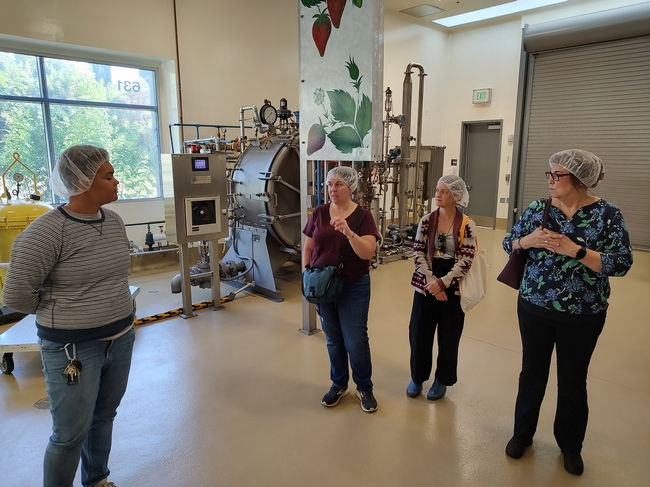- Author: Olivia Henry
Pilot Plant manager Amy Fletcher talks with UCCE staff in front of a rotary steritort – which Fletcher likened to “an Instant Pot but faster” – that quickly brings canned, jarred or bottled food up to the lethal temperature for pathogens then rapidly cools the food down with cold water. Photo: Olivia Henry
Food processing – meaning any activity such as chopping, peeling, freezing, milling or preserving that makes raw food ready to eat – is a critical and sometimes overlooked part of the food system. At UC Davis, several food processing facilities within the Department of Food Science and Technology serve the university community as well as regional and international businesses. To learn more, staff members from UC Cooperative Extension (UCCE) Capitol Corridor and UCCE Placer-Nevada visited the California Processing Tomato Industry Pilot Plant and Carlos Alvarez Food Innovation Lab last month.
Pilot plant available for industry research
At the pilot plant, UCCE staff members learned how the 4,000-square-foot facility serves undergraduate education, academic research, university extension and food businesses. Those businesses have ranged from a five-person startup developing a poke recipe to multinational manufacturers such as Mars, Incorporated.
The facility can only be used for research purposes and not commercial production, plant manager Amy Fletcher explained. Much of the equipment would need to be retrofitted or replaced to process food under a retail food permit. For illustration, Fletcher pointed to the facility's Atlas Pacific Peach Pitter/Aligner, believed to be the oldest of its type in California.
While the pilot plant isn't a co-packer, “it's a great place to do a proof of concept [for a product],” Fletcher said. “For example, does a $2 million machine do what it says it's going to do before you buy it.”
More than a dozen machines and processing lines – including a freeze dryer, a lye line, a sorting line and flume washer – are available for use. The pilot plant stays busy with an undergraduate class using the facility plus university research projects on peaches, plums and tomatoes in the summer.
Food innovation lab busy with students, UC research
The Carlos Alvarez Food Innovation Lab is more heavily used by students, with classes using the lab four days a week. While the lab cannot be rented by outside groups like the pilot plant, it is available to UC affiliates as well as faculty who partner with food businesses to do consumer research. Lab manager Matthew Ford regularly hosts restaurant groups who are doing consumer testing as part of research partnerships.
Fletcher shows off a high-pressure processing (HPP) unit that is used to pasteurize food without heat. Its most common use is for refrigerated goods such as juice, hummus, guacamole and seafood. Photo: Olivia Henry
Food Innovation Lab Manager Matthew Ford talks with Sacramento Master Food Preserver Coordinator Wendi Weston. Photo: Olivia Henry




